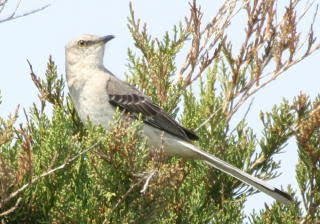.jpg)
© Dave Spier
Mockingbirds now are noted consistently on Christmas Bird Counts in their adopted home of Upstate New York. If there's one common thread, it's probably their association with Multi-flora Rose thickets.
Once considered a southern species, the mockingbird not only has expanded its range northward, but it is now found there year-round, in large part due to the widespread presence of Multi-flora Rose bushes and their small, bite-size fruits. Mockers reportedly defend fruit trees and berry bushes in their winter territory, but I have yet to see this. Cedar Waxwings, which can strip a tree or shrub of its fruits in hours are particularly prone to being attacked by mockingbirds. Have you ever witnessed this behavior? Mockers, which are larger, have been reported going so far as killing waxwings by pecking them to death.
The Northern Mockingbird (Mimus polyglottos) is most noted for its talent of imitating other bird calls. Each sound is repeated three or more times before moving on to a different song from its repertoire. Not being content to stop there, it also accurately mimics sirens, musical instruments, squeaky hinges, burglar alarms and other urban sounds. During the breeding season and even into the fall, this serenade can last into the night. Native Americans named it “cencontlatolly,” meaning “400 tongues.” Mimus polyglottos means “mimic of many-tongues.”
Mockers are most attractive in flight when their dark wings flash prominent white patches. At rest, a bit of the white still shows. Their long tails are also dark and edged in white. Otherwise, the birds are gray on top and light underneath. In size and shape, mockingbirds are similar to their relatives, the catbirds and thrashers.
.jpg)
Corrections, comments and questions are always welcome at northeastnaturalist@yahoo.com or connect through my Facebook page and photo page. Other nature and geology topics can be found on the parallel blogs Adirondack Naturalist and Heading Out. There's also a community-type page for The Northeast Naturalist.